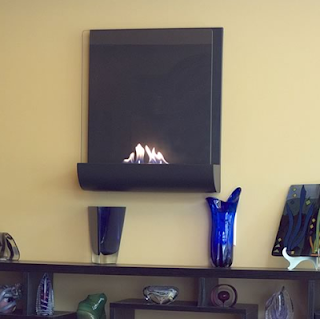
What makes a biofuel fireplace different from your typical modern fireplace? Essentially, biofuel does. A biofuel fireplace runs on a special type of liquid, consisting largely of bioethanol. High quality bioethanol fuels contain up to 96.6%. The liquid is a byproduct of sugar fermentation, as well as from wheat and potatoes. You can’t get any greener than oil made right out of agricultural and forestry products.
The main advantage that biofuel fireplaces have over conventional fireplaces is that it’s also a much healthier alternative to fossil fuel sources. Because of this, there is no need for a chimney to direct smoke away and out of your house. Biofuel fireplaces don’t emit as much residual carbon as a regular fireplace. While they do release a small amount of smoke, biofuel fireplaces produce smoke that is clean. . Just as with traditional fireplaces though, it’s good to have a well-ventilated room before installing one.
One liter of biofuel typically burns for up to three hours, though this could also depend on the type of fireplace you have. Fireplaces have varying aperture sizes on the steel burner box, and the size of the opening will factor significantly into how much of the biofuel burns. Smaller bioethanol fireplaces tend to burn much longer because their burner boxes have smaller apertures. You need to make sure that there’s enough ventilation in the room to promote burning. Keep a window slightly open to allow the air to fully circulate in the room.
When setting up your biofuel fireplace, simply follow the instructions included in the packaging. This is often important, as there can be different makes and models of various fireplaces. Check that all the parts you need are in the box. If you have no prior experience to setting up a fireplace, you might want to have a friend around who has some.
Tips to using biofuel fireplaces
Place the biofuel fireplace somewhere it can benefit from good ventilation, preferably in a cool, dry spot. Remove any flammable materials like cloth or paper anywhere near the fireplace. The biofuel itself should be placed in a tightly sealed container that’s well out of the reach of children.
When you’ve set up your fireplace, don’t place bottles of bioethanol fuel or lighters or anything of the sort near the fireplace itself. Store them away in a cool and dry area where it might not inadvertently cause a fire hazard.
Biofuel burns best at room temperature. If the room is below 10 degrees Celsius or 50 degrees farenheit, the fuel might have trouble lighting. You’ll need to strike a balance between letting in enough air to promote ventilation, and keeping enough out to keep things from getting too cold.
While a biofuel fireplace is a good secondary source of heat, it’s not an ideal source of heat for cooking. You really wouldn’t want to do your cooking in the living room, would you?



No comments:
Post a Comment